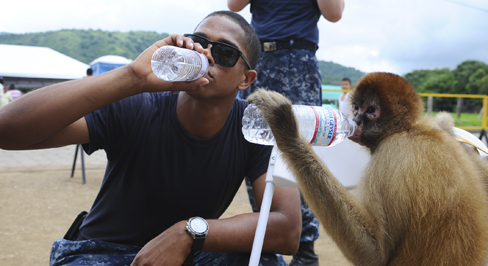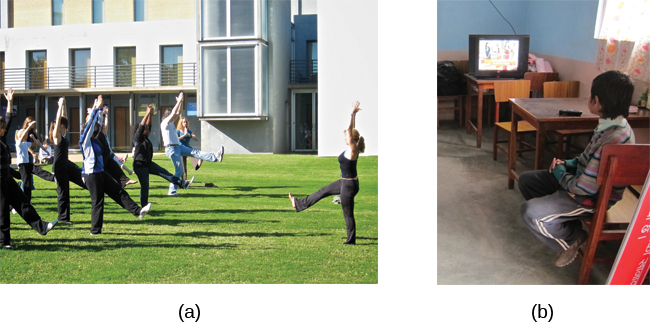64 Observational Learning
Learning Objectives
By the end of this section, you will be able to:
- Define observational learning
- Discuss the steps in the modelling process
- Explain the prosocial and antisocial effects of observational learning
Previous sections of this chapter focused on classical and operant conditioning, which are forms of associative learning. In observational learning, we learn by watching others and then imitating, or modelling, what they do or say. For instance, have you ever gone to YouTube to find a video showing you how to do something? The individuals performing the imitated behaviour are called models. Research suggests that this imitative learning involves a specific type of neurone, called a mirror neurone (Hickock, 2010; Rizzolatti, Fadiga, Fogassi, & Gallese, 2002; Rizzolatti, Fogassi, & Gallese, 2006).
Humans and other animals are capable of observational learning. As you will see, the phrase “monkey see, monkey do” really is accurate (Figure L.16). The same could be said about other animals. For example, in a study of social learning in chimpanzees, researchers gave juice boxes with straws to two groups of captive chimpanzees. The first group dipped the straw into the juice box, and then sucked on the small amount of juice at the end of the straw. The second group sucked through the straw directly, getting much more juice. When the first group, the “dippers,” observed the second group, “the suckers,” what do you think happened? All of the “dippers” in the first group switched to sucking through the straws directly. By simply observing the other chimps and modelling their behaviour, they learned that this was a more efficient method of getting juice (Yamamoto, Humle, and Tanaka, 2013).

Like Tolman, whose experiments with rats suggested a cognitive component to learning, psychologist Albert Bandura’s ideas about learning were different from those of strict behaviourists. Bandura and other researchers proposed a brand of behaviourism called social learning theory, which took cognitive processes into account. According to Bandura, pure behaviourism could not explain why learning can take place in the absence of external reinforcement. He felt that internal mental states must also have a role in learning and that observational learning involves much more than imitation. In imitation, a person simply copies what the model does. Observational learning is much more complex. According to Lefrançois (2012) there are several ways that observational learning can occur:
- You learn a new response. After watching your coworker get chewed out by your boss for coming in late, you start leaving home 10 minutes earlier so that you won’t be late.
- You choose whether or not to imitate the model depending on what you saw happen to the model. Remember Naomi and their parent, Yao? When learning to surf, Naomi might watch how Yao pops up successfully on their surfboard and then attempt to do the same thing. On the other hand, Naomi might learn not to touch a hot stove after watching Yao get burned on a stove.
- You learn a general rule that you can apply to other situations.
Bandura identified three kinds of models: live, verbal, and symbolic. A live model demonstrates a behaviour in person, as when Yao stood up on their surfboard so that Naomi could see how they did it. A verbal instructional model does not perform the behaviour, but instead explains or describes the behaviour, as when a soccer coach tells their young players to kick the ball with the side of the foot, not with the toe. A symbolic model can be fictional characters or real people who demonstrate behaviours in books, movies, television shows, video games, or Internet sources (Figure L.17).

Steps in the Modelling Process
Of course, we don’t learn a behaviour simply by observing a model. Bandura described specific steps in the process of modelling that must be followed if learning is to be successful: attention, retention, reproduction, and motivation. First, you must be focused on what the model is doing—you have to pay attention. Next, you must be able to retain, or remember, what you observed; this is retention. Then, you must be able to perform the behaviour that you observed and committed to memory; this is reproduction. Finally, you must have motivation. You need to want to copy the behaviour, and whether or not you are motivated depends on what happened to the model. If you saw that the model was reinforced for their behaviour, you will be more motivated to copy them. This is known as vicarious reinforcement. On the other hand, if you observed the model being punished, you would be less motivated to copy them. This is called vicarious punishment. For example, imagine that four-year-old Lake watched their older sibling Opal playing with their parent’s makeup, and then saw Opal get a time out when their parent came in. After their parent left the room, Lake was tempted to play in the make-up, but did not want to get a time-out from their parent. What do you think Lake did? Once you actually demonstrate the new behaviour, the reinforcement you receive plays a part in whether or not you will repeat the behaviour.
Bandura researched modelling behaviour, particularly children’s modelling of adults’ aggressive and violent behaviours (Bandura, Ross, & Ross, 1961). He conducted an experiment with a five-foot inflatable doll that he called a Bobo doll. In the experiment, children’s aggressive behaviour was influenced by whether the teacher was punished for their behaviour. In one scenario, a teacher acted aggressively with the doll, hitting, throwing, and even punching the doll, while a child watched. There were two types of responses by the children to the teacher’s behaviour. When the teacher was punished for their bad behaviour, the children decreased their tendency to act as the teacher had. When the teacher was praised or ignored (and not punished for her behaviour), the children imitated what the teacher did, and even what the teacher said. They punched, kicked, and yelled at the doll.
Link to Learning
Watch this clip about the famous Bobo doll experiment to see a portion of the experiment and an interview with Albert Bandura (more about this experiment can be found in the Psychological Research chapter).
What are the implications of this study? Bandura concluded that we watch and learn, and that this learning can have both prosocial and antisocial effects. Prosocial (positive) models can be used to encourage socially acceptable behaviour. Parents in particular should take note of this finding. If you want your children to read, then read to them. Let them see you reading. Keep books in your home. Talk about your favourite books. If you want your children to be healthy, then let them see you eat right and exercise, and spend time engaging in physical fitness activities together. The same holds true for qualities like kindness, courtesy, and honesty. The main idea is that children observe and learn from their parents, even their parents’ morals, so be consistent and toss out the old adage “Do as I say, not as I do,” because children tend to copy what you do instead of what you say. Besides parents, many public figures, such as Martin Luther King, Jr. and Mahatma Gandhi, are viewed as prosocial models who are able to inspire global social change. Can you think of someone who has been a prosocial model in your life?
The antisocial effects of observational learning are also worth mentioning. Research suggests that this learning may help to explain why children who experienced abuse often grow up to abuse others (Murrell, Christoff, & Henning, 2007). Children who experience abuse, who grow up witnessing their parents deal with anger and frustration through violent and aggressive acts, often learn to behave in that manner themselves. Sadly, it’s a vicious cycle that’s difficult to break.

